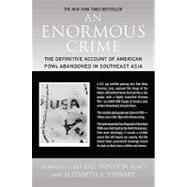
Note: Supplemental materials are not guaranteed with Rental or Used book purchases.
Purchase Benefits
What is included with this book?
Former U.S. Rep. Bill Hendon (R-NC) served two terms on the U.S. House POW/MIA Task Force (1981–1982 and 1985–1986), as a consultant on POW/MIA affairs with an office in the Pentagon (1983), and as a full-time intelligence investigator assigned to the Senate Select Committee on POW/MIA Affairs (1991–1992). He has traveled to South and Southeast Asia thirty-three times on behalf of America’s POWs and MIAs. Hendon is considered the nation’s foremost authority on intelligence relating to American POWs held after Operation Homecoming and is an expert on the Vietnamese and Laotian prison systems. He lives in Washington, D.C.
Elizabeth A. Stewart’s father, Col. Peter J. Stewart (USAF), is missing in action in North Vietnam. His name appears on Panel 6E, Line 12, of the Vietnam Veterans Memorial in Washington, D.C. She has spent more than two decades researching intelligence relating to American POWs and MIAs. Her efforts have taken her from Capitol Hill to Cambodia, from the South China Sea to the presidential palace in Hanoi, and to the most remote regions of northern Vietnam. An attorney, she lives in Winter Haven, Florida.
| Preface | p. xv |
| Introduction | p. 3 |
| The POW Hostage Plan and Its Implementation | p. 11 |
| Hanoi Bound | p. 19 |
| American POWs Captured by the Pathet Lao | p. 26 |
| American POWs in North Vietnam | p. 28 |
| 1972: The War Draws to a Close | p. 46 |
| January 1973: Peace at a Very High Price | p. 63 |
| February 1973: A Historic Journey to Hanoi | p. 76 |
| February-March 1973: The "Most Tortured" Issue, "The Toughest Sale" | p. 82 |
| Mid- to Late March 1973: The Returnee Debriefs Tell of Hundreds of American POWs Held Back | p. 92 |
| Spring 1973: "A 'Cancer' on the Presidency" | p. 98 |
| Spring, Summer, and Fall 1973: The Collapse of the JEC Talks - The Collapse of the Paris Peace Accords | p. 108 |
| 1974: The End of the LIne for Richard Nixon | p. 117 |
| January-April 1975: The End of the Line for South Vietnam | p. 120 |
| May-December 1975: "Cuba Suggested to Us to Keep Them Back" - Congress Investigates the Fate of the POWs and MIAs | p. 127 |
| 1976: Montgomery Continues His Investigation - American POWs Seen in Captivity in Both North and South Vietnam | p. 140 |
| 1977: A New President Addresses the Matter of the Unlisted, Unreturned POWs | p. 156 |
| 1978: The Sightings of the Unlisted, Unreturned POWs Continue - The Refugee Exodus Begins | p. 175 |
| 1979: A Prison System in Chaos - Convincing Evidence Finally Reaches Washington | p. 188 |
| 1980: Rescue Plans | p. 206 |
| 1981: "Gasoline" | p. 215 |
| 1982: "The Principle of Reciprocity" | p. 224 |
| 1983: A Dramatic Change of Course | p. 232 |
| 1984: Tragedy at Arlington - A Missed Opportunity in the Oval Office | p. 248 |
| 1985: "Progress" in the Search for Remains - Freshmen, Stonewalled on POWs, Turn to Perot - McFarlane Drops His Guard | p. 266 |
| 1986: Trench Warfare | p. 287 |
| 1987: Perot to Hanoi - A Bombshell from General Vessey - No Evidence? | p. 323 |
| 1988: "Just Two Bar of Silvers for Each Man" | p. 347 |
| 1989: "...The Statute of Limitations Has Been Reached" | p. 367 |
| 1990: Sabotaging the Helms/Grassley Investigations - The Bush Final Report on POWs - Thach's Historic Visit to Washington | p. 378 |
| 1991: One Last Chance to Save the Unlisted, Unreturned POWs | p. 399 |
| 1992: The Fragging | p. 408 |
| 1993-1995: "The Vietnamese Know How to Count" | p. 465 |
| 1995-2005: "War Legacies" | p. 480 |
| Epilogue: A Proposal for President Bush | p. 483 |
| A Message from the Authors | p. 487 |
| Notes | p. 489 |
| Acknowledgments | p. 565 |
| Index | p. 567 |
| Table of Contents provided by Ingram. All Rights Reserved. |
The New copy of this book will include any supplemental materials advertised. Please check the title of the book to determine if it should include any access cards, study guides, lab manuals, CDs, etc.
The Used, Rental and eBook copies of this book are not guaranteed to include any supplemental materials. Typically, only the book itself is included. This is true even if the title states it includes any access cards, study guides, lab manuals, CDs, etc.
Excerpted from Enormous Crime: The Definitive Account of American POWs Abandoned in Southeast Asia by Bill Hendon, Elizabeth A. Stewart
All rights reserved by the original copyright owners. Excerpts are provided for display purposes only and may not be reproduced, reprinted or distributed without the written permission of the publisher.